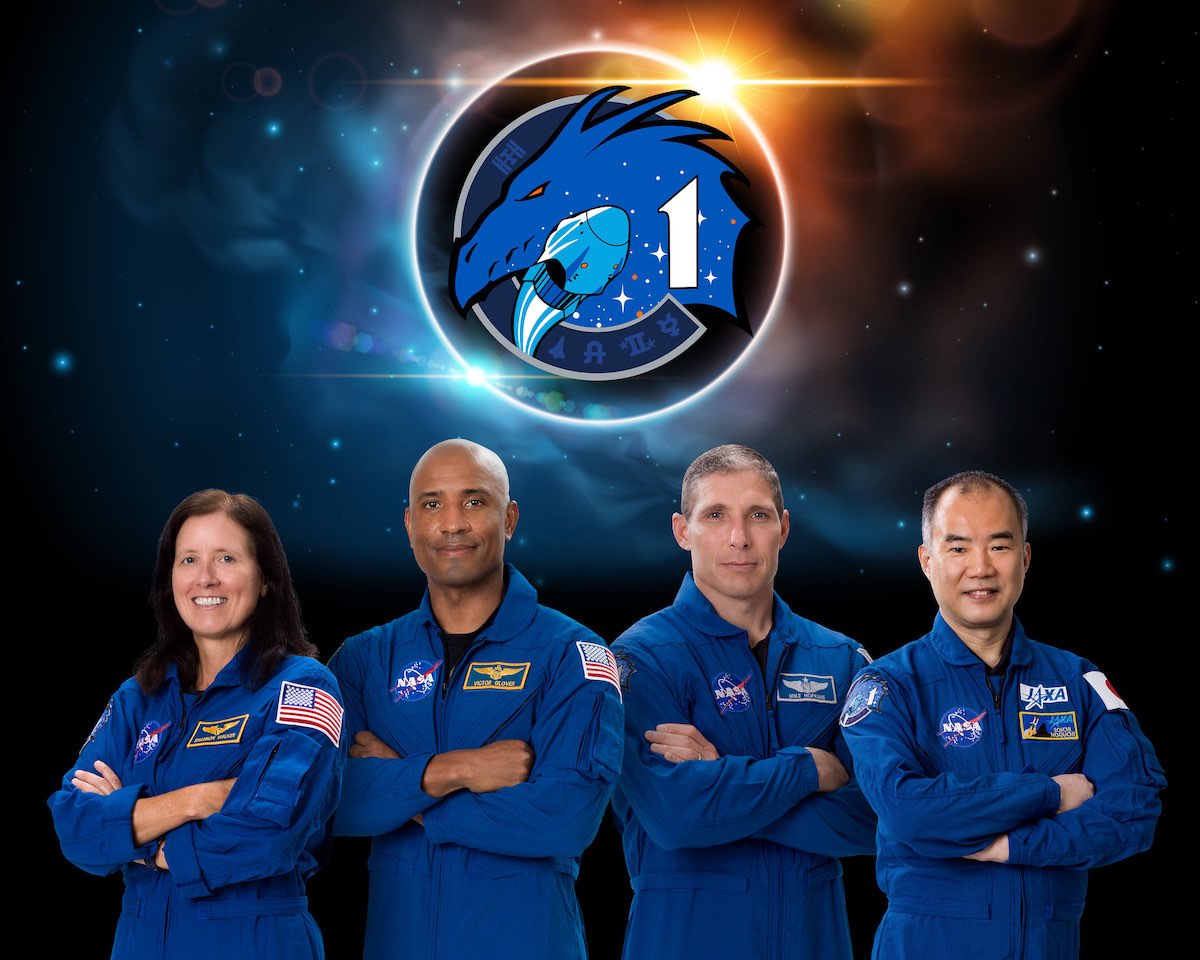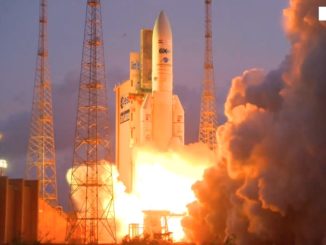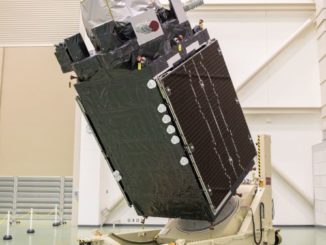
NASA announced Monday that the launch of the first operational crew rotation mission to the International Space Station on SpaceX’s Crew Dragon spacecraft is set for the predawn hours of Halloween, eight days later than previously planned.
The Crew Dragon spaceship is scheduled to blast off atop a Falcon 9 rocket from pad 39A at NASA’s Kennedy Space Center in Florida at around 2:40 a.m. EDT (0640 GMT) on Oct. 31, the space agency said.
If the mission takes off as scheduled, the crew capsule will dock with the International Space Station around a day later, either late on Oct. 31 or early Nov. 1.
Commander Michael Hopkins will lead the four-person crew. He will be joined by pilot Victor Glover and mission specialists Shannon Walker and Soichi Noguchi to kick off a six-month expedition on the space station.
The mission, known as Crew-1, was previously scheduled for launch Oct. 23. NASA said the delay to Oct. 31 will “deconflict” the Crew 1 launch and docking with the scheduled arrival Oct. 14 of a three-person Soyuz crew at the space station, and the departure and landing of an outgoing station crew Oct. 21.
“This additional time is needed to ensure closure of all open work, both on the ground and aboard the station, ahead of the Crew-1 arrival,” NASA said.
The delay will also give engineers more time to conduct additional testing to isolate a small air leak inside the space station’s pressurized cabin. Greg Dorth, NASA’s manager of the space station external integration office, said Monday that the leak is “very, very small.”
“The leak is not a safety of crew nor a safety of station issue,” Dorth said Monday. “It’s a very, very small leak. It’s an impact to our consumables, but we have planned for that. We can address the leak as we continue the investigation.”
The space station’s three residents spent three days isolated in the Russian segment of the complex in August, and the crew spent another weekend in the Russian section of the station last weekend in a bid to help ground teams isolate the location of the leak.
“As of this morning, there was no clear indication of where the leak is,” Dorth said Monday. “The teams are still looking at the data and evaluating it, and we will continue to search for this very, very small leak.”
NASA said SpaceX “continues to make progress on preparations of the Crew Dragon spacecraft and Falcon 9 rocket, and the adjusted date allows the teams additional time for completing open work ahead of launch.”
Hopkins and his crewmates finished training on Crew Dragon systems last week at SpaceX headquarters in Hawthorne, California. “We’ve got our license to fly!” Glover tweeted.
Crew-1 is complete with Dragon Rider training. We’ve got our license to fly! Thank you to all that made this possible. We hope to make you proud! pic.twitter.com/HA2AYz77Bj
— Victor Glover (@VicGlover) September 26, 2020
The Crew-1 mission follows a successful test flight known as Demo-2, in which NASA astronauts Doug Hurley and Bob Behnken flew to the space station on a two-month mission to wring out the human-rated capsule before officials clear it for regular missions.
Hurley and Behnken launched May 30 and returned to Earth on Aug. 2.
Beginning with Crew-1, SpaceX plans to launch multiple Crew Dragon missions per year with NASA astronauts, international crew members, and fare-paying private passengers. NASA is in the final stages of formally certifying the Crew Dragon for operational missions.
Noguchi also tweeted last week that the Crew-1 astronauts had completed their final underwater spacewalk training at NASA’s Neutral Buoyancy Laboratory near the Johnson Space Center in Houston. Astronauts train in a giant pool to mimic the weightless conditions in orbit.
#NASA #SpaceX #Crew1 final spacewalk underwater training is completed, with flying colors! Thanks all the divers and support operators at #NBL and instructors at #JSC! pic.twitter.com/CzJo9ZLeB5
— NOGUCHI, Soichi 野口 聡-(のぐち そういち) (@Astro_Soichi) September 25, 2020
NASA plans to host a series of press conferences Tuesday to preview the Crew-1 mission.
The four-person crew set for launch Oct. 31 will remain aboard the space station until around April 2021, when another Crew Dragon spacecraft is set to dock with a fresh four-person team of astronauts. Hopkins and his crewmates will then depart in their Crew Dragon capsule to head for a parachute-assisted splashdown in the Atlantic Ocean or Gulf of Mexico.
SpaceX’s Crew Dragon spacecraft is one of two new U.S. spaceships designed to ferry astronauts to and from the space station. Developed under a multibillion-dollar contract with NASA, the commercial Crew Dragon capsule is also configured to carry private astronauts into low Earth orbit, beginning with a 10-day mission next October that is expected to include actor Tom Cruise.
Boeing’s Starliner crew capsule is designed the same types of missions as the Crew Dragon. But the Starliner program has run into delays, an an unpiloted test flight of a Starliner spacecraft in December 2019 prematurely ended after a software error prevented it from docking with the space station.
NASA and Boeing have agreed to launch a second Starliner test flight without astronauts to ensure the software issues are resolved before the first Starliner demonstration mission with crew members.

The second unpiloted Starliner test flight is currently scheduled for launch in January aboard a United Launch Alliance Atlas 5 rocket. If it goes well, Boeing could be ready to fly another Starliner to the space station with Boeing test pilot Chris Ferguson and NASA astronauts Mike Fincke and Nicole Mann no earlier than June 2021.
Then NASA could approve Boeing’s Starliner to begin regular trips to and from the space station. NASA’s contracts with Boeing and SpaceX each include provisions for six crew rotation missions to the space station through 2024.
While the new U.S. vehicles are coming online, Russian Soyuz missions will continue transporting space station crews in the coming years. Russian technicians at the Baikonur Cosmodrome in Kazakhstan are readying the Soyuz MS-17 spacecraft for launch at 1:45 a.m. EDT (0545 GMT) Oct. 14 with Russian cosmonauts Sergey Ryzhikov, Sergey Kud-Sverchkov, and NASA astronaut Kate Rubins for their own six-month stint on the space station.
Ryzhikov, Kud-Sverchkov and Rubins will dock with the space station around three hours after liftoff, joining station commander Chris Cassidy and his Russian crewmates Anatoly Ivanishin and Ivan Vagner.
Cassidy, Ivanishin and Vagner have been on the space station since April. They are due to depart the station and return to Earth in their Soyuz MS-16 capsule Oct. 21.
Email the author.
Follow Stephen Clark on Twitter: @StephenClark1.



